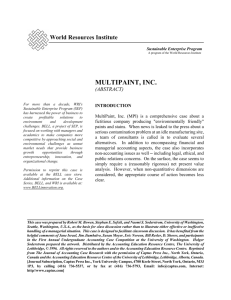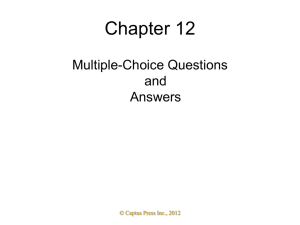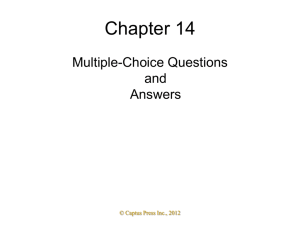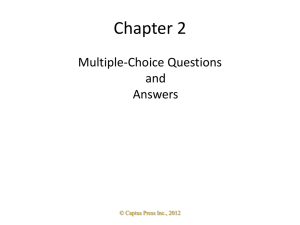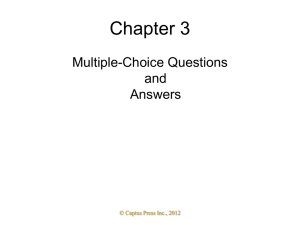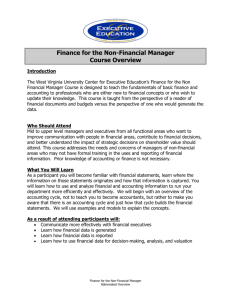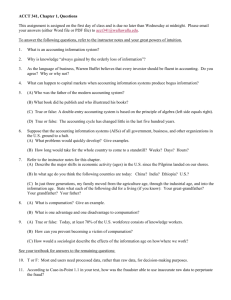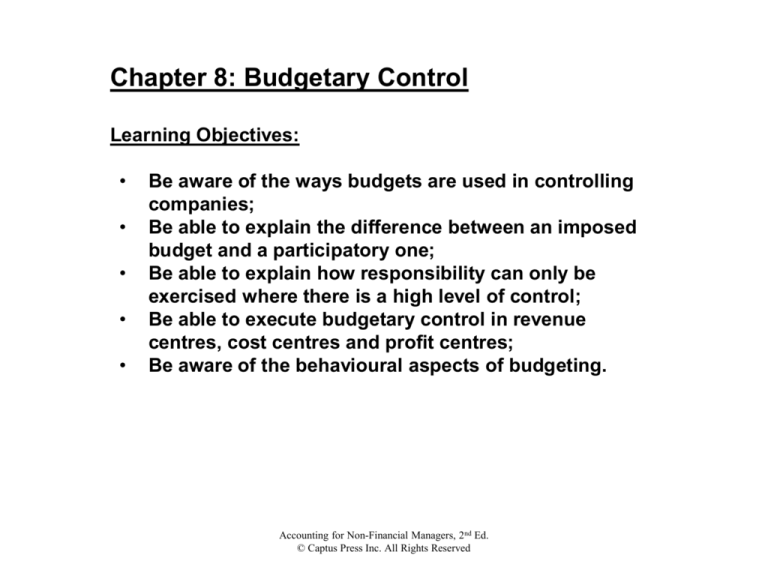
Chapter 8: Budgetary Control
Learning Objectives:
•
•
•
•
•
Be aware of the ways budgets are used in controlling
companies;
Be able to explain the difference between an imposed
budget and a participatory one;
Be able to explain how responsibility can only be
exercised where there is a high level of control;
Be able to execute budgetary control in revenue
centres, cost centres and profit centres;
Be aware of the behavioural aspects of budgeting.
Accounting for Non-Financial Managers, 2nd Ed.
© Captus Press Inc. All Rights Reserved
Budgetary Control:
The budget will be used to control operations.
Once the budget is “agreed” it represents a social
contract between the parties:
• The budget is accepted by the operatives as being
achievable;
• The budget is accepted by management as meeting
their needs.
Comparison of budget with the actual results will reveal
the extent to which it has, or has not, been achieved.
Deviations from budget should be investigated:
• To reveal the responsibility area where the problem
arose;
• To initiate any corrective action
Accounting for Non-Financial Managers, 2nd Ed.
© Captus Press Inc. All Rights Reserved
Exhibit 8.1: Management by Exception — Budgetary Control
Establish organizational
objectives.
Create an operating budget.
Carry out business activities.
Provide explanations.
Implement necessary corrective actions
Measure actual outcomes.
Calculate an actual
operating statement for the unit.
Compare actual outcomes
with objectives.
Compare actual profit (or cost)
with budgeted profit (or cost).
If outcomes do not meet
objectives, investigate and
act as necessary.
Is actual profit less than
budgeted profit, or is actual cost
greater than budgeted cost?
If outcomes meet objectives, continue to next
control period.
Is actual profit equal to or greater than budgeted
profit, or is actual cost less than budgeted cost?
Accounting for Non-Financial Managers, 2nd Ed.
© Captus Press Inc. All Rights Reserved
Participation in Budgeting:
An imposed budget is handed down
from above without negotiation: it is
typical of an authoritarian management
style.
A participative budget is one that has
been negotiated and agreed by the
parties involved: it is likely to have a
higher level of commitment from users.
Which budget is appropriate depends
on situational factors.
Accounting for Non-Financial Managers, 2nd Ed.
© Captus Press Inc. All Rights Reserved
Responsibility & Control:
A manager can be held RESPONSIBLE
for those factors that she/he can
CONTROL or STRONGLY INFLUENCE.
A manager should not be held
responsible for other factors.
Accounting for Non-Financial Managers, 2nd Ed.
© Captus Press Inc. All Rights Reserved
Control in Revenue Centres:
Appropriate dimensions of control:
Was the sales budget met?
may be measured in units, sales $ or contribution margin;
Additionally (but far less important):
Was the actual expense within budget?
Accounting for Non-Financial Managers, 2nd Ed.
© Captus Press Inc. All Rights Reserved
Control in Cost Centres: Service Departments:
Appropriate dimensions of control:
Was the service objective executed?
(quantity of service; quality of service).
Was the actual expense within budget?
Accounting for Non-Financial Managers, 2nd Ed.
© Captus Press Inc. All Rights Reserved
Control in Cost Centres: Production Departments:
Appropriate dimensions of control:
Was the production output in line with budget?
Was the actual cost per unit within budget?
Accounting for Non-Financial Managers, 2nd Ed.
© Captus Press Inc. All Rights Reserved
Control in Profit Centres:
Appropriate dimensions of control:
Was the actual profit at least as much
as the budgeted profit?
Accounting for Non-Financial Managers, 2nd Ed.
© Captus Press Inc. All Rights Reserved
Control in Investment Centres:
Appropriate dimensions of control:
Was the actual return on assets at
least as much as the budgeted
return on assets?
Accounting for Non-Financial Managers, 2nd Ed.
© Captus Press Inc. All Rights Reserved
The Balanced Scorecard:
Budgetary control focuses on the financial results of the
organization. If the organizational strategy can be expressed
solely in financial terms, then that is acceptable. Most
organizations have strategies that are wider in scope, so a more
comprehensive approach to planning and control is necessary.
The balanced scorecard is a way of envisioning strategy and
measuring progress towards its achievement. The four
sections commonly used are:
financial perspective;
customer perspective;
internal business perspective;
learning & growth perspective.
This articulates and communicates a balanced approach to
strategic management.
Accounting for Non-Financial Managers, 2nd Ed.
© Captus Press Inc. All Rights Reserved
Carberry Hotels: Balanced Scorecard for September 2002
Objective
Measure
Target
Actual
Financial perspective:
Shareholder value
Return on investment 15.0%
15.6%
Share price growth
5.0%
6.0%
Customer perspective:
Quantity
Occupancy rates
90.0%
93.2%
Quality
Room rack-rate growth 4.0%
0.0%
Customer satisfaction 9/10
9.3/10
Written complaints
nil
nil
Internal business perspective:
Cleanliness
Random checks
10/10
10/10
Restaurant
Menu changes
5
6
Accessibility
Wheelchair access
98.0%
98.0%
Learning & growth perspective:
Staff training
Training hours
100
75
Market segments
New segments targeted
2
1
Product development New facilities
1
0
Accounting for Non-Financial Managers, 2nd Ed.
© Captus Press Inc. All Rights Reserved
Carberry Hotels: Balanced Scorecard for September 2002
They have met or exceeded their targets in respect of:
Financial perspective:
Customer perspective:
Internal business perspective:
But, it has failed to meet its targets for learning & growth.
Have they compromised their future to achieve immediate
success?
Accounting for Non-Financial Managers, 2nd Ed.
© Captus Press Inc. All Rights Reserved
Behavioural aspects of Budgeting:
Budgets feed into managers expectations and
motivations through:
•
Budget setting:
(participative vs. imposed, optimistic vs. realistic);
•
Budgetary control:
(tight control vs. loose control);
•
Goal congruence;
•
Integration with the reward system.
Accounting for Non-Financial Managers, 2nd Ed.
© Captus Press Inc. All Rights Reserved

